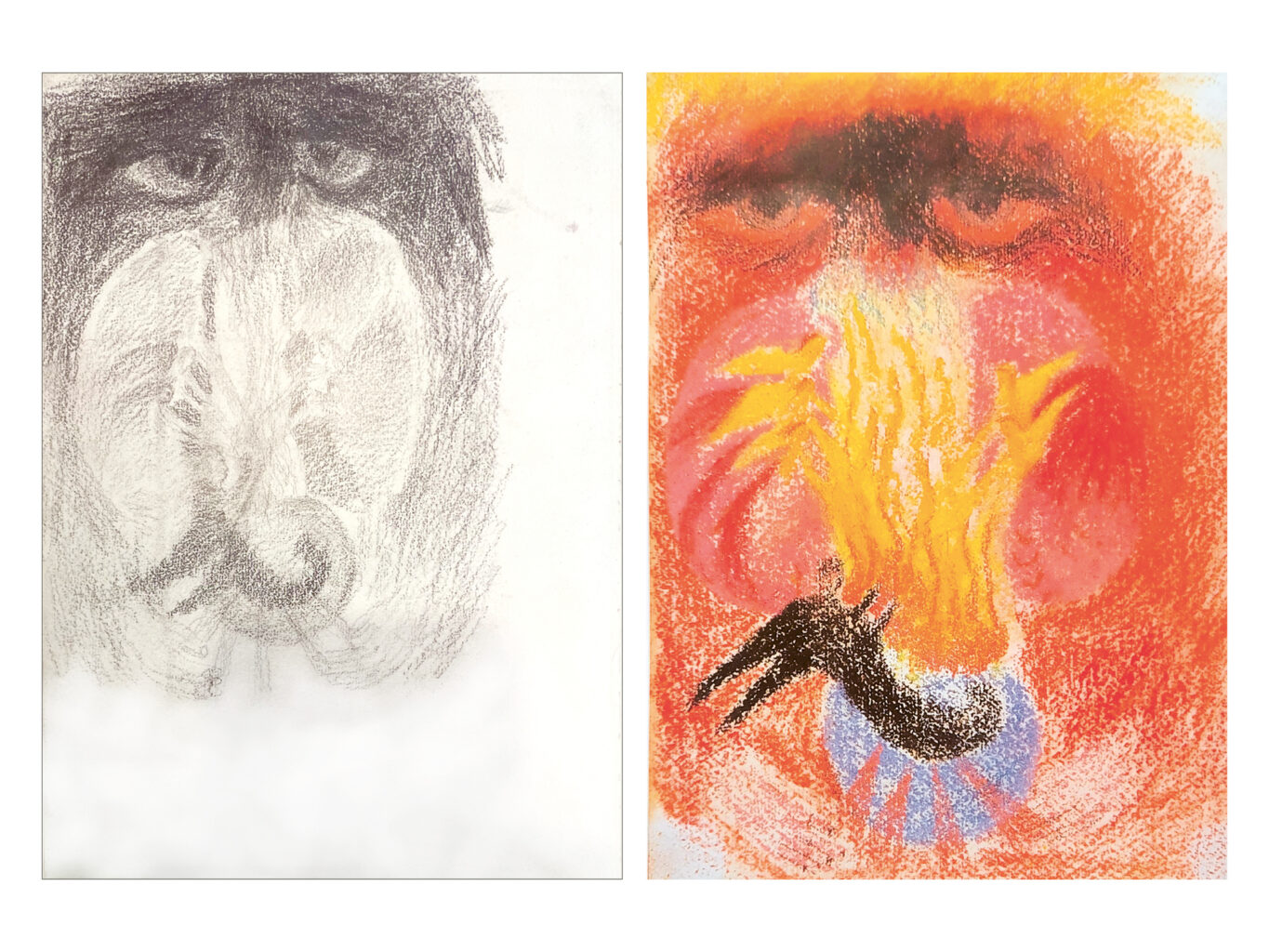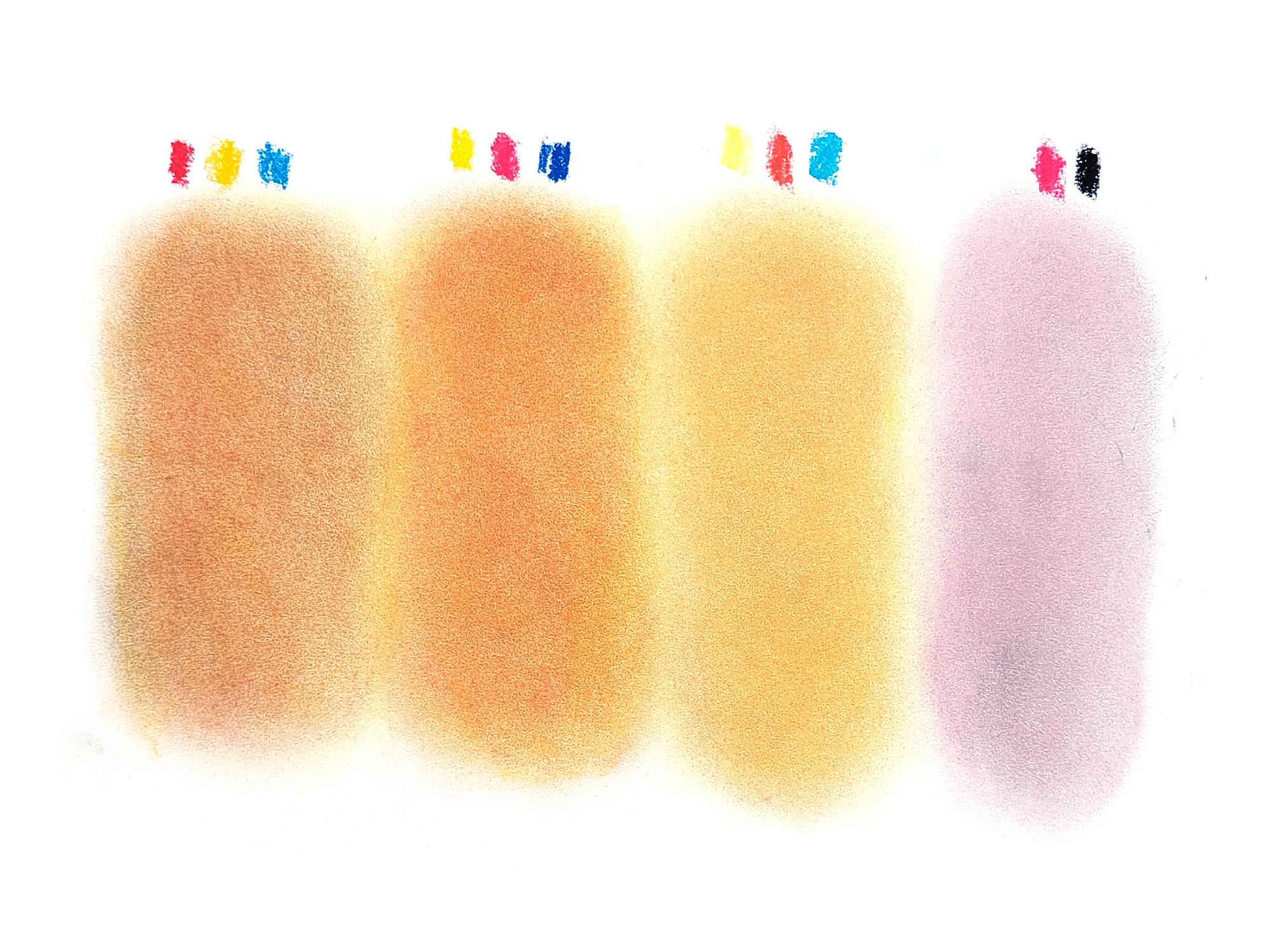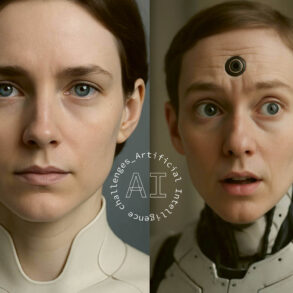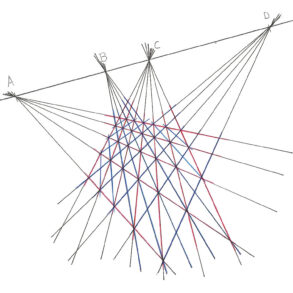What is delicate and vulnerable finds an initial expression in pink. A shade further is peach blossom, which is related to human incarnation. In conversation with Christiane Haid, this special colour appears as a threshold between spirit and matter. Gilda Bartel asked the questions.
What is your relationship with the colour pink?
Christiane Haid: I am currently encountering pink in great abundance and many shades on the roses in my garden. I also admire it as the colour of dawn as often as I can when I first look up at the sky after getting up. There is only a fleeting moment in which dawn can unfold, then the delicate colours quickly fade, and the day emerges with the rising sun. Dawn speaks directly to the soul and creates in me a sense of awe and wonder at being touched in my soul by this delicate colouring and solemnity. It is always just a brief and intimate moment when this subtle vibration becomes visible in the morning sky. It speaks of something transient.
Over the past few weeks, we have been exploring this transient, subtly vibrating, and delicate quality—which is also evident in human skin tones—with artists and laypeople in painting workshops in Vienna and The Hague. We can approach the colour of human flesh by combining the three primary colours red, blue, and yellow. All three colours are mixed such that each painter can find their own individual skin tone. Depending on whether it is a cool or a warm yellow, a cool or a warm red, and how these are mixed, a different note is produced in each case. When a delicate pinch of blue, which also ranges from warm to cool, is then added, interesting mixtures are created that are always a little different. In applying different layers, which works well with pastels, the art is to bring the colours together in such a way that a floating, vibrating field is created on the sheet that looks like something living. It is a joy to immerse your soul in such weaving of the colours and to treat the colours in such a way that they themselves begin to come to life. Then you can have the feeling that something essential is weaving to animate the field.
How do the participants describe their perceptions of skin colour?
It is a challenge to fully trust in the power of colour and not to follow the often-emerging need to first structure the sheet with lines or points. You have to be ready to enter the ocean of colours. It is not easy to create an even field that is alive in itself. You have to let go of your own preconceptions to a certain extent. If you succeed in engaging with the power of the colours, moving experiences can arise: to which colour do I give preference? Blue can be very defining and creative but requires careful use and restraint in the amount of colour applied. Then there are people who quickly make friends with yellow and red and are content if they have a nice, bright orange. But then there is a lack of depth and vibrancy. It is a complex process before flesh colour really comes into being.
It is exciting to search and look until the colour pigments are configured in such a way that they begin to vibrate and form a living field. This search is about becoming sensitive to colours being forces and beings that have qualities that speak to me and challenge me. The next step in the exercise would be to connect inwardly with the field and slowly allow a face to emerge from the whole. The question is, then, can you develop such a selfless and non-conceptual relationship with the painted surface that the face actually comes towards you, in other words, that it emerges as a counterpart and is not just “made” by you from your own ideas?
Rudolf Steiner also calls flesh “peach blossom,” right?
Yes, and in his theory of colour, skin colour is an image colour. Image colours are, as the name suggests, an “image” of something. The being itself is not visible; similar to a mirror image, the being casts its shadow. Skin colour or peach blossom is created, as Rudolf Steiner describes it, by bringing black and white together and finally adding red: “Imagine that this black and white were not still, but that they moved within each other, that they undulated within each other […]. If I were able to choose the right shade, I would get peach blossom through this intermingling of black and white, into which I let the red shine.” 1 Peach blossom thus becomes a “living image of the soul element.” Elsewhere, Rudolf Steiner describes skin colour as a subtle weaving between turning pale and blushing. We are, therefore, always dealing with a living movement in the sphere of the soul element.
How would you distinguish flesh colour or peach blossom from pink?
I think the question is whether it is a diluted red or whether this oscillating colour tone can come about. Here, the mixture is not so crucial, whether white, black, and red, or the three lustre colours blue, yellow, and red.
What happens when we take this pink or flesh colour within us? What does it mean for our cognition or experience?
This reminds me of an aphorism by Novalis from Pollen, which says, “The mysterious path leads inwards. Eternity with its worlds—the past and the future—is within us, or nowhere. The outside world is the shadow world—it casts its shadow into the realm of light. At present, to be sure, it seems inwardly so dark, lonely, shapeless—but how completely different it will seem to us when the eclipse is over and the body of shadow has moved away—we will delight more than ever, for our spirit has been bereft.” (No. 17) The world that appears to us during the day is referred to here as the shadow world, which obscures the realm of light. The path inwards initially leads into the night, into darkness and eclipse. But this night is not just black for Novalis. In the 4th “Hymn to the Night,” it says: “Does not everything that enthuses us bear the colour of night?”
The night became a new world for Novalis after the death of his beloved Sophie, whom he initially wanted to follow into death: “Downwards I turn towards the sacred, ineffable, mysterious night […]. More heavenly than those sparkling stars do the infinite eyes appear to us that the night has opened within us.” (1st Hymn). In the sphere of the night he celebrated his reunion with Sophie: “[…] there came from blue yonder – from the heights of my old bliss a twilight shudder—and all at once the cord of birth—the shackle of light broke. Earthly splendour fled away and my grief with it—melancholy coalesced into a new, unfathomable world—enthusiasm of the night, slumber of heaven that you are, came over me—the land gently rose; my unbound, newborn spirit floated over the land.” Here in the “heaven of the night” he meets his beloved, who is the light of this night. Thus, night becomes a source of inspiration. What was once darkness begins to brighten for the eyes that have become seeing. In other words, this is the crossing of the threshold.
Newton, due to his theoretical approach, only considered the daytime spectrum of colours in his colour theory and not the night-time spectrum. As a careful observer, Goethe had an eye for the big picture and, in his experiments, perceived and added the dark spectrum, which is how he discovered the colour magenta. For me, magenta is connected with peach blossom, the flesh colour tone and thus with the dark spectrum. For me, his discovery not only relates to the theory of colour, it also has a philosophical dimension. Because if you follow Newton, then only that which is assigned to the day would be valid. This eliminates the night world, the space of inspiration, the sphere of the spirit that speaks from the dark spectrum.
And the thing is that the dark spectrum, we might also say the blackness, has two layers. On the one hand, it is the mighty world of the highest hierarchies supporting the earthly ground, the Father Ground; and on the other hand, it is the place where the dark forces and powers manifest themselves. Seen from the perspective of the theory of colour, the blackness is ambiguous. I believe it would be beneficial to concern ourselves with these broader perspectives. In the age of the consciousness soul, the challenge is to face the darkness with the radiance of consciousness and to illuminate it.
Does the red in the skin colour mixture of black/white/red correspond to the will to face up to the confrontation between light and dark?
My favourite motif in the ceiling painting of the first Goetheanum—it can also be seen in the second—is “God’s wrath and God’s melancholy”, an impressive motif. Gazing out of the black, two divine eyes look down on the human being. The spirit of darkness, Ahriman, can be seen below these eyes. Angels are depicted in between, possibly trying to soothe this spirit with fire and light. The whole is held by two hands. With regard to our time, we could say that we look very much into the darkness and do not see what is at work as light and what people also think, feel, and meditate positively.
How does our seeing itself become flesh-coloured? How do we learn to see differently?
Here, observing the flesh colour made by other people is a wonderful field. How do the proportions used in mixing manifest themselves? Is there a tendency towards the reddish or more towards the pale? The effect of colours or how people deal with colours is revealing. In Europe, I find that people sometimes find strong colours difficult to tolerate. Black, white, grey, or even shades of brown predominate both in clothing and in home furnishings, as if a strong colour is almost too much, almost like a shock. A red coat can be perceived as intrusive.
The experience of colour could, therefore, be cultivated to a greater extent, as colour has a positive effect on the soul. In colourful rooms, I have the feeling of experiencing an envelope. I feel myself in a relationship of forces determined by colour, and that has a beneficial effect. A yellow wall can work wonders in bad weather. More attention would be good in the field of colour effects. In the Visual Art Section, we have just had our Ascension Conference in The Hague. The topic was the creative power of colour in art, architecture, therapy, science, etc. The participants were all in a joyful and uplifted mood and mentally energised. Colour is a vital element of the soul; we could become much more aware of the fact that colours have a direct formative effect on the soul. Playfully working with this would be productive and stimulating. Then you would also experience that colour is a force that really gives you something.

How does the soul react to peach blossom?
We are always unconsciously following how the other person displays the fine balance between blushing and paling, but also between fatigue or a certain lifelessness and exhaustion, just as when we observe an enthusiastic person whose face is animated in a gentle blush. You can observe how every person almost constantly shows a subtle vibration in these relationships of equilibrium.
So flesh colour as a movable threshold?
Yes. It’s not fixed at all. If someone is ill, for example, we can see that yellowish or even greenish tendencies appear or even bluish in people who are cold. We have a permanent perception of the other person’s state of life but rarely realise it. That is the exciting thing about the image colours black, white, peach blossom, and green. As Steiner describes it, green is the dead image of life. We cannot see what is the living part in plants. The colour green shows us, as it were, the dead image of the life behind it, which we cannot perceive with our ordinary consciousness. Flesh colour is the living image of the soul element. White is the soul image of the spirit. And black is the spiritual image of death. These formulations are actually like a meditation. It starts from the physical and extends via the soul element into the spiritual, always describing the respective forms of relationship, combined with the question as to the imagery. I find that really exciting.
“What radiates outwards in flesh colour is nothing other than the human being experiencing themselves as a soul within themselves. […] And we can say that what we have before us in flesh colour as colour is the image of the soul. So we see the soul of the human being, but however far you travel in the world you will find that we have to choose peach blossom for that which appears as human flesh colour, as otherwise we don’t actually find it in external objects. After all, we can only achieve it through all sorts of tricks in painting. For that which appears as human flesh colour is already an image of the soul. But it is not, there can be no doubt about that, of the soul itself. It is the living image of the soul.” (From Das Wesen der Farben [Colour], first and second lecture).
I find that something very special. And the lustre colours, i.e. blue, red and yellow, have a luminosity of their own—they are not just an image of something but the essence itself expresses itself much more directly. It is the external side of the essential nature. The image colours green, peach blossom, black and white, in contrast, are cast images, something shadowy. It would be nice and motivating if we perceived other people much more in such a way that we could read the expression of the soul in what we encounter as flesh colour.
Colour is the threshold for incarnating from the abstract, for daring to allow the soul a life. A threshold of interior, exterior, day colours, night colours. A threshold on which spirit appears?
Your question reminds me of an enigmatic passage in Jakob Böhme, the 500th anniversary of whose death occurs this year. In his work Aurora, he says: “then the DAWN breaks / he who breaks through with the innermost birth revealed himself with his red / green / and white flag in the outermost birth on the rainbow.” 2 The transition between the light, which stands for day, and the darkness, which stands for night, is formed by morning and evening. They are an effect of the sun, which was created on the fourth day of creation. The “dawn” of which Böhme writes points to other spheres by speaking of someone “who breaks through with the innermost birth.” We might call it the spiritual birth of the human being, and it is probably no coincidence that the colours red and green bring to mind the Rosicrucian meditation. The inner breakthrough in understanding the riddle of morning and evening takes place in polarity with the outermost birth on the rainbow, as a colourful bridge between the earthly and the spiritual world, the image of the birth of the spiritual human being in the new covenant with God.
Translation Christian von Arnim
Title image Studies on skin tones by Christiane Haid










I was concerned to read the description of peach blossom and the differentiations of “flesh color” which seemed to refer only to members of the “white” skin color groups. The article seemed to ignore totally the large number of human beings with dark skins which could not be outwardly, visibly “animated in a gentle blush.” There is an enormous range of skin tones (or flesh colors, if you prefer that term) and I am sorry that no account was taken of this obvious fact.
I agree with Nancy Foster. Skin color or flesh tone in human beings has a huge range of colors. I believe that Incarnadine is a better word to describe this color.
I tell my students that in order to achieve incarnadine, use red, blue and yellow paint and allow them to mix so that a brownish red appears. This color has a range that is any color that human skin can be, including the color inside your mouth. See how it feels when it is light and also when it is dark. Just as blue can be light or dark, incarnadine can also have a full range of strengths.
It is time for Anthroposophy to acknowledge that human beings have many skin tones.